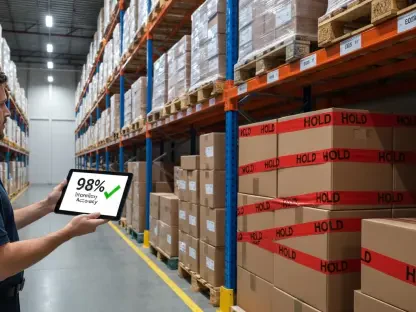Introduction to a Critical Industry Challenge
The heavy truck industry, a backbone of the American economy, is facing a seismic shift as new tariffs on medium- and heavy-duty vehicles (MHDVs) take effect. These vehicles, responsible for transporting over 70% of the nation’s freight, including vital supplies like food, fuel, and medical equipment, are now at the center of a heated policy debate. With imports accounting for 43% of Class 4 to Class 8 vehicles sold in the US, the decision to impose significant tariffs has sparked discussions about national security, economic stability, and the delicate balance of international trade relations. This report dives into the intricacies of the policy, its implications for domestic manufacturing, and the controversies it has ignited across the industry.
Overview of the Heavy Truck Sector in the US
The heavy truck industry plays an indispensable role in sustaining the US economy and ensuring national security. Medium- and heavy-duty vehicles, encompassing large pickup trucks, cargo trucks, dump trucks, and tractors for eighteen-wheelers, form the lifeline of logistics, moving essential goods across vast distances. Their significance extends beyond commerce, as these vehicles are critical for military readiness, disaster response, and infrastructure maintenance, making their reliability a matter of strategic importance.
Major players in this sector include well-known manufacturers like Freightliner, Peterbilt, and International, which dominate domestic production. However, the reliance on imported vehicles remains substantial, with a significant portion of the market sourced from overseas. This dependency raises concerns about supply chain vulnerabilities, especially in times of geopolitical tension or global disruptions, prompting policymakers to reevaluate the balance between domestic capabilities and foreign supply.
The current state of domestic manufacturing reveals a mixed landscape. While the US boasts robust assembly and production facilities, the high percentage of imported Class 4 to Class 8 vehicles underscores gaps in self-sufficiency. Addressing this imbalance has become a focal point for industry stakeholders and government officials alike, setting the stage for protective measures aimed at bolstering local production.
Unpacking the New Tariff Policy
Specifics of the Tariff Proclamation
On October 17, President Donald Trump issued a proclamation introducing tariffs on heavy trucks, effective from November 1. This policy imposes a 25% tariff on Class 3 to Class 8 vehicles, which include a wide range of heavy-duty trucks, while buses face a 10% levy. The measure targets a broad spectrum of vehicles critical to various industries, aiming to curb the influx of imported units that dominate a significant share of the market.
To soften the impact on domestic manufacturers, the proclamation includes specific exemptions and offsets. Starting this year, US-assembled MHDVs qualify for a 3.75% import adjustment offset, extending until October 31, 2030. A parallel relief measure applies to carmakers until April 2030, acknowledging the interconnected supply chains between the heavy truck and automotive sectors. These provisions aim to support American assembly operations while addressing import dependencies.
Additionally, the policy integrates considerations under the United States-Mexico-Canada Agreement (USMCA). Qualifying trucks and parts under this agreement are subject to exemptions, with tariffs applied only to non-US content for compliant vehicles. Potential reductions of up to 50% on tariffs for Canadian and Mexican steel and aluminum suppliers further reflect an effort to maintain collaborative trade ties with close allies.
Strategic Objectives of the Tariffs
The rationale behind these tariffs centers on safeguarding national defense and critical infrastructure. The White House has emphasized that over-reliance on imported MHDVs poses risks to military operations, troop movements, and emergency response capabilities. By incentivizing domestic production, the policy seeks to ensure a steady supply of vehicles essential for both security and economic functions during crises.
Beyond security concerns, the tariffs aim to strengthen economic stability by revitalizing the US manufacturing base. The administration views the heavy truck sector as a cornerstone of industrial resilience, arguing that reducing import dependence will create jobs and fortify supply chains. This protectionist stance is intended to prioritize American industries amid growing global uncertainties.
Balancing these goals with international trade dynamics remains a challenge. While the tariffs are designed to protect domestic interests, provisions under the USMCA demonstrate a commitment to preserving partnerships with Canada and Mexico. This dual approach highlights the complexity of implementing trade barriers without alienating key allies or disrupting shared production networks.
Challenges and Controversies of the Tariff Implementation
The introduction of tariffs on heavy trucks has not been without criticism, as stakeholders grapple with potential economic repercussions. One primary concern is the increased cost burden on manufacturers, which could trickle down to consumers and industries dependent on MHDVs. Higher prices for vehicles may strain budgets for logistics companies, ultimately impacting the cost of goods nationwide.
Supply chain disruptions pose another significant hurdle. Given the integrated production networks with Canada and Mexico, sudden trade barriers risk interrupting the flow of components and assembled vehicles. This interconnectedness raises fears of inefficiencies and delays, potentially undermining the very industries the tariffs aim to protect.
Moreover, the specter of retaliatory trade measures looms large. Critics argue that imposing tariffs could strain relationships with key trading partners, leading to reciprocal actions that harm American exports. The debate continues over whether these protective measures will genuinely enhance domestic production or instead create friction, reducing overall economic efficiency and global competitiveness.
Regulatory and Trade Frameworks Shaping the Policy
The USMCA plays a pivotal role in structuring the tariff framework, offering exemptions for qualifying vehicles and parts. Under this agreement, only non-US content in compliant trucks is subject to taxation, while USMCA-compliant MHDV parts remain tariff-free until a formal process for taxing non-US content is established. This nuanced approach seeks to minimize disruption for allied suppliers.
Broader trade regulations also influence the policy’s scope. Heavy trucks are exempt from additional sectoral tariffs on materials such as steel, aluminum, and copper, reflecting a targeted focus on vehicle imports rather than raw inputs. Such exemptions aim to prevent compounding cost pressures on manufacturers already navigating the new tariff landscape.
Compliance and oversight mechanisms further define the policy’s implementation. The Secretary of Commerce, alongside US Customs and Border Protection, is tasked with developing processes to assess and tax non-US content in parts. This regulatory framework ensures that the tariffs are applied with precision, balancing enforcement with the practical realities of international supply chains.
Long-Term Implications for the Heavy Truck Industry
Looking ahead, the tariffs are poised to reshape the landscape of domestic manufacturing in the heavy truck sector. By incentivizing local production, the policy could spur investment in US facilities, potentially reducing the 43% reliance on imported vehicles. However, achieving this shift will require sustained commitment from both industry players and government support to address capacity constraints.
Market competitiveness and consumer costs are also likely to evolve. While domestic production may strengthen over time, short-term price increases for MHDVs could impact purchasing decisions and operational budgets. Innovation in manufacturing processes and technologies might emerge as a response, driving efficiency to offset higher costs.
On a global scale, trade dynamics with Canada and Mexico will be crucial to monitor. These partners may adapt by restructuring supply chains or seeking alternative markets, potentially altering the flow of goods across North America. As economic conditions continue to shift, the heavy truck industry must navigate these tariffs within the broader context of international supply chain resilience.
Reflecting on the Path Forward
Looking back, the implementation of tariffs on heavy trucks marked a defining moment for the US industry, driven by a clear intent to protect national security and economic stability. The policy’s intricate balance of protectionism with trade collaboration under the USMCA revealed a strategic effort to address vulnerabilities while maintaining key alliances. Its immediate impacts stirred debates over costs, supply chain disruptions, and the effectiveness of bolstering domestic production.
Moving forward, policymakers should prioritize targeted support for manufacturers to expand capacity and absorb cost increases, ensuring that the goal of self-reliance does not come at the expense of affordability. Industry leaders, in turn, must explore innovative solutions to enhance efficiency and competitiveness amid changing trade landscapes. Collaborative dialogue with Canada and Mexico will be essential to mitigate tensions and preserve integrated supply networks, paving the way for a more resilient future in the heavy truck sector.









